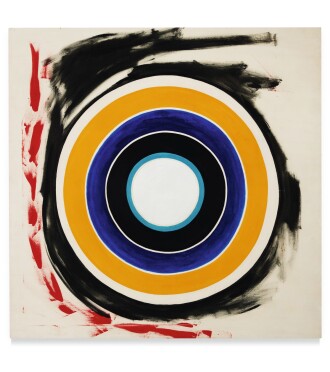Works by Kenneth Noland at Sotheby's
Kenneth Noland Biography
Born in Asheville, South Carolina, in 1924, Kenneth Noland is today recognized as one of the most important contributors to Color Field painting. His father was, as Noland described, a “Sunday painter,” or amateur artist; his stock of brushes, paints and other materials allowed a young Noland to experiment with painting, and influenced his later decision to pursue art. In 1942, he graduated from high school and voluntarily joined the US Armed Forces, and spent almost four years in the Air Force.
Following his time in military, he benefitted from the G.I. Bill by enrolling at Black Mountain College near his hometown. There, the remarkable faculty of artists exposed him to a broad array of artistic methods and modes; through Ilya Bolotowsky, Noland was introduced to geometric abstraction and Neo-Placticism, and through Josef Albers he discovered the work of Paul Klee. He spent approximately two years at Black Mountain College before, in 1948, he traveled to Paris, France, to study with the sculptor Ossip Zadkine—though Zadkine’s strict adherence to Cubism would ultimately alienate Noland. In reaction, Noland began focusing on color and form, influenced by his previous teachings from Albers. Upon his return to the US, he supported himself in the late 1940s and 1950s by teaching at various institutions in the Washington, DC area, and through his involvement in the arts scene of the city he met and befriended like-minded artists such as Morris Louis and David Smith. In 1953 Noland and Louis visited the New York studio of Helen Frankenthaler, escorted by Clement Greenberg. The day had a profound impact on the artist; Frankenthaler’s method of applying thin layers of pigment to raw, unprimed canvas would inspire Noland (and Louis) to later adopt this color-staining technique—the two artists would later be recognized as the primary pioneers of the Washington Color School.
By the late 1950s, Noland began exhibiting his first, now iconic, canvases composed of concentric circles of various colors. In the early 1960s, feeling that the “Circle” painting motif had been exhausted, he began expanding his formal composition to include abstracted chevrons. A selection of his works, alongside those by Louis, Frankenthaler, Ellsworth Kelly, Frank Stella, and others, were included by Greenberg in the seminal group exhibition Post-Painterly Abstraction at the Los Angeles County Museum of Art; the term was coined by Greenberg, and has largely been associated with all the artists shown in the exhibition since. Later the same year, Noland participated in representing the United States at the Venice Biennale, where he showed both his “Circle” and “Chevron” paintings alongside work by Louis, Jasper Johns and Robert Rauschenberg.
Noland began spending an increasing amount of time away from New York City and instead in rural Vermont beginning in the early 1960s, where he developed close friendships with the artists Jules Olitski and Anthony Caro—all of who shared his devotion to abstraction. Noland never ceased experimenting with his chosen motifs throughout the rest of his career, and continually produced bold compositions until his death in 2010. Noland’s ability to synthesize various mid-century artistic modes, from geometric abstraction to color theory, both solidified his oeuvre in the art historical canon of the period, but also helped herald in later movements such as Minimalism and Neo Geo. His works are held in the collections of the Solomon R. Guggenheim Museum, New York; the Museum of Fine Arts, Houston; the National Gallery of Art, Washington, DC; and the Tate Modern, London.












